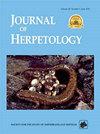Salinity Conditions during the Larval Life Stage Affect Terrestrial Habitat Choice in Juvenile Wood Frogs (Lithobates sylvaticus)
IF 0.8
4区 生物学
Q3 ZOOLOGY
引用次数: 1
Abstract
Abstract. Anthropogenic salinization is a pervasive pollutant in much of the northeastern United States because of the widespread use of chemical deicing agents on roads. Although studies have examined the physiological effects of salinization on amphibians across life stages, behavioral responses to salinization of habitats are less studied. In this study, we experimentally test how salinity and temperature conditions experienced as larvae affect behavioral and physiological responses as juveniles. We first experimentally test whether juvenile Wood Frogs (Lithobates sylvaticus) can detect and avoid road salt in terrestrial soils and whether this avoidance behavior differs depending on temperature and salinity conditions in which individuals were raised as larvae. We also experimentally test whether temperature and salinity conditions experienced as larvae affect desiccation rates in juvenile Wood Frogs. We found a significant correlation between larval salinity conditions and choice of soil, with frogs raised in high salt aquatic conditions spending the majority of time on high salinity soils and frogs raised in low salt aquatic conditions spending the majority of time on low salinity soils. This behavioral response was muted in frogs raised in elevated temperature conditions. We were unable to detect a correlation between larval treatment and desiccation rate. Our experiments demonstrate that Wood Frogs can detect and respond to salinity levels in terrestrial habitats and that this juvenile response depends on environmental conditions experienced as larvae.林蛙幼体盐度对陆生栖息地选择的影响
摘要由于在道路上广泛使用化学除冰剂,在美国东北部的大部分地区,人为盐碱化是一种普遍存在的污染物。虽然研究已经检查了盐碱化对两栖动物在整个生命阶段的生理影响,但对栖息地盐碱化的行为反应的研究较少。在这项研究中,我们通过实验测试了盐度和温度条件如何影响幼虫的行为和生理反应。我们首先通过实验测试了幼年林蛙(Lithobates sylvaticus)是否可以探测和避免陆地土壤中的道路盐,以及这种避免行为是否取决于个体作为幼虫饲养的温度和盐度条件。我们还通过实验测试了幼体经历的温度和盐度条件是否会影响幼年林蛙的干燥率。我们发现幼虫盐度条件与土壤选择之间存在显著相关性,在高盐水生条件下饲养的青蛙在高盐土壤上花费大部分时间,而在低盐水生条件下饲养的青蛙在低盐土壤上花费大部分时间。在高温条件下饲养的青蛙,这种行为反应是沉默的。我们无法发现幼虫处理与干燥率之间的相关性。我们的实验表明,林蛙可以探测并响应陆地栖息地的盐度水平,而这种幼蛙的反应取决于幼虫所经历的环境条件。
本文章由计算机程序翻译,如有差异,请以英文原文为准。
求助全文
约1分钟内获得全文
求助全文
来源期刊

Journal of Herpetology
生物-动物学
CiteScore
1.60
自引率
0.00%
发文量
45
审稿时长
6 months
期刊介绍:
The Journal of Herpetology accepts manuscripts on all aspects on the biology of amphibians and reptiles including their behavior, conservation, ecology, morphology, physiology, and systematics, as well as herpetological education. We encourage authors to submit manuscripts that are data-driven and rigorous tests of hypotheses, or provide thorough descriptions of novel taxa (living or fossil). Topics may address theoretical issues in a thoughtful, quantitative way. Reviews and policy papers that provide new insight on the herpetological sciences are also welcome, but they must be more than simple literature reviews. These papers must have a central focus that propose a new argument for understanding a concept or a new approach for answering a question or solving a problem. Focus sections that combine papers on related topics are normally determined by the Editors. Publication in the Long-Term Perspectives section is by invitation only. Papers on captive breeding, new techniques or sampling methods, anecdotal or isolated natural history observations, geographic range extensions, and essays should be submitted to our sister journal, Herpetological Review.
 求助内容:
求助内容: 应助结果提醒方式:
应助结果提醒方式:


